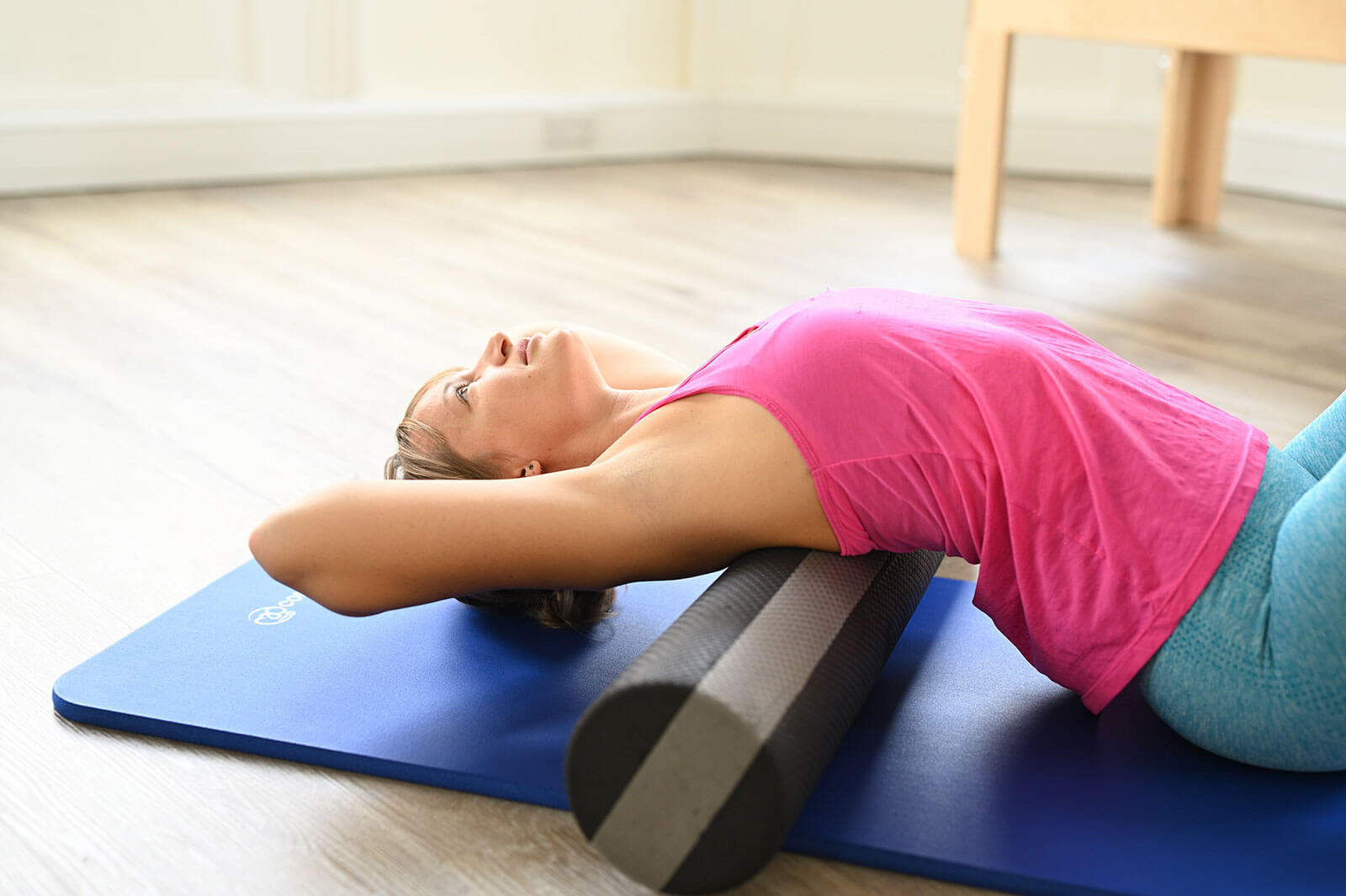Are you suffering from upper back pain? With more of us spending time sitting at a desk, hunching over a device, it is a great time to prevent upper back pain from being a problem for you. Luckily, relief can come from upper back Pilates exercises.
Why Do Pilates for Upper back pain?
Sitting for prolonged periods of time is known to contribute to upper back pain. It can cause increased stress on the back, neck, arms and legs for a number of reasons.
- Reduced blood flow to the muscles and joints
- Reduced movement of the fluid in the joints
- Lack of activation of the muscles
- Reduced active length of the muscles whilst you ae sat still
- Fatigue of the postural muscles
However, with simple yet effective stretches for upper back pain, you can help to prevent back pain occurring instead of having to treat back pain.
Whether it’s sitting at a desk that has contributed to upper back pain, or it’s as a result of an injury, stretches can be incorporated into your everyday routine easily so you have no excuse not to do them!
How to perform stretches for upper back pain safely
Before you start stretching, it is important to consider how to stretch correctly and safely to ensure you don’t injure yourself.
Here are some tips on how to perform stretches for upper back pain safely:
- Stretch regularly during the day taking breaks from your sitting position to do it. We recommend that you move at least once every hour.
- Warm up before stretching with gentle exercise such as walking, going up and down stairs and prepare with some breathing exercises.
- Hold static stretches for 10-30 seconds without bouncing. Dynamic (moving) stretches should again be done without bouncing and not too fast.
- Don’t stretch to the point of pain, only stretch to the point where you can start to feel it.
- Breathe normally.
- Don’t bounce whilst stretching this can cause the muscles to actually tighten further.
- Focus on major muscles groups such as your calves, thighs, hips, lower back, neck and shoulders.
9 Examples of upper back stretches
1. Neck Rolls
Neck rolls are a simple yet effective stretch for relieving pain and tension in your neck and upper back. This type of stretch can be done just about anywhere, whether you’re seated or standing.
- Relax your shoulders, place your hands either on your lap or by your sides.
- Gently lean your right ear over your right shoulder (remember to keep your shoulders relaxed and not lifted).
- Keep your chin down and turn the head to look at the right shoulder
- Return to looking forwards and then bring the head back to the start position.
- Repeat 5 times in each direction.
Neck rolls are designed to reduce stress and release tension of the spine by relaxing and stretching the neck muscles and the cervical spine. You can do this regularly during the day to keep your neck moving and reduced upper back pain.
We advise avoiding this pose if you suffer from high blood pressure or have eye problems.
2. Shoulder Rolls
Similar to neck rolls, shoulder rolls are a simple stretch for upper back pain which can be done seated or standing.
- Place your arms down at your sides.
- Roll your shoulders backwards in a circular motion by lifting your shoulders to your ears, backwards and down in a circle.
- Repeat the same movement circling the shoulders forward.
- Repeat 5-10 times in both directions.
Shoulder rolls can help to prevent and relieve tension headaches, as well release muscle tension in your neck, shoulders and upper back. You can also try lifting the elbows higher to increase the shoulder blade movement for a bigger stretch.
3. Chair Rotation
If you find yourself sitting at a desk for long periods of time, this stretch for upper back pain can be done from the comfort of your chair.
- Sit sideways on your chair, resting your right side against the back of the chair.
- Rotate your torso to the right, holding the back of the chair with your hands.
- Hold for 10 seconds, breathe into the ribcage and repeat 3 times on each side.
4. Cat Cow
The cat cow stretch is quick and easy to do.
- Start on all fours in quadruped with a neutral spine.
- As you inhale, tuck your pelvis by imagining you are tucking your tail between your legs, round your spine upwards into cat pose and release your head toward the floor.
- On your exhale, move into cow pose, reverse the movement lifting your tail bone first and then letting the rest of your spine follow.
- Try and reach your breastbone forwards so that the upper back extends.
- Repeat this 5 times.
The cat cow pose offers a number of benefits including relieving upper back pain, improving posture and balance, strengthening the spine and neck and increasing coordination to name a few.
5. Child’s Pose
Child’s pose is designed to stretch the shoulders, upper, mid and lower back.
- Begin by kneeling on the floor with your knees wide and feet together, resting your palms on the floor in front of you.
- Lower your torso between your knees, extending your arms above your head with your palms facing downwards. Remember to relax your shoulders.
- Reach your hips back towards your heels.
- Breathe into the rib cage and try and release tension each time you breathe out.
- Hold for 15 seconds. Repeat 2-3 times coming up between reps.
Child’s pose is often recommended to release tension in the back, shoulders and chest, as well as to promote relaxation by alleviating stress and anxiety.
6. Seated mermaid
The Pilates mermaid overhead arm reach is a perfect seated stretch you can do at your desk to release tension in the neck and shoulders and is perfect for helping to reduce upper back pain.
- Sit in your chair or stand with your feet hip-width apart.
- Extend your right arm above your head and reach up and out of your pelvis, start to reach over to the left until you can feel the stretch along the right side of your torso.
- Hold the stretch as you breathe into your ribcage on the right side before returning to your starting position.
- Repeat on the other side and do 5-10 repetitions.
This is a simple and easy to do stretch for upper back pain which can be done while standing or sitting, wherever you are. It can also be gentle or more intense if you wish to reach a deeper range of motion for increased challenge.
7. Thoracic extension
The thoracic extension stretch can be done easily in your desk chair. You can also progress it by doing it lying on your back and using a foam roller.
- Using a chair, sit tall at the back of the chair and reach your hands behind your head to support your head.
- Reach tall and lean back through your upper back maintaining the lower back in neutral.
- Using a foam roller, lie on your back and position it under your thoracic spine.
- Support your head with your hands as above and reach the upper back over the roller maintaining the neutral spine in the lower back.
Thoracic extensions are important for preventing and helping back pain as we tend to spend a lot of time sitting in thoracic flexion and can easily get stiff. This then has a knock on effect on your function through the whole of your upper body.
8. Book opening in sitting
This is another perfect exercise you can do even whilst sat at your desk. It targets not only the rotation of your upper back but also the shoulders opening up the front of your chest and stretching your pecs.
- Sit tall in your chair with your arms out in front of your palms together.
- Draw one hand towards you by tracing it along the inside of the other arm so that your hand comes to your chest.
- As you do so start to turn the chest twisting through the upper body but keeping the lower body still.
- Open the arm reaching your fingers behind you, take a breath before folding the arm back in and returning to the start position.
- Repeat on alternate sides 5-10 times
9. Goal posts
Goal posts is the perfect stretch for upper back pain targeting the neck, shoulders and upper back. It is a bit of a challenge as well to see if you can keep your body, head and arms on the wall as you go through the movement.
- Standing with your back flat against a wall, with the back of your head against the wall too.
- Extend your arms to create a “T” shape against the wall.
- Bend your elbows in a 90 degree angle.
- Gently move your arms arm and down creating a “snow angel” shape keeping them against the wall, how high can you lift the arms?!
- Repeat 5-10 times.
The wall angel stretch enables you to strengthen your back as well as prevent rounded shoulders, improve shoulder rotation and improve thoracic spine mobility.
Summary of stretches for upper back pain
If you are suffering from upper back pain and would like to see a professional to help relieve your pain, at Complete Pilates, we have Physiotherapists and Clinical Pilates instructors who can tailor Pilates sessions to your problems and objectives.
By bringing movement into your treatment, it can help to increase the mobility of the spine and alleviate any pressure contributing to upper back pain. Pilates will also help to build your strength and therefore, improve posture.
We have a range of options for you to access clinical Pilates
These blogs are designed to give information to everyone, however, it is important to remember that everyone is different! If you have not seen one of our therapists and have any questions about injuries, what you have read or whether this may be useful to you, please just ask. We are more than happy to help anyone and point you in the right direction. Our biggest belief is that education is key. The more you understand about your injury, illness and movement, the more you are likely to improve.




